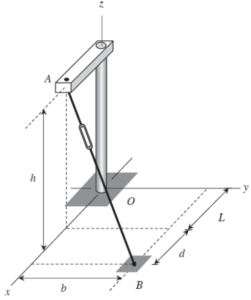Problem statements
Solution video - H6.A
Solution video - H6.B
DISCUSSION THREAD

Please post questions here on the homework, and take time to answer questions posted by others. You can learn both ways.
Problem statements
Solution video - H6.A
Solution video - H6.B
DISCUSSION THREAD

You must be logged in to post a comment.
Is anyone else getting a moment that's pointing in the opposite direction from what's expected by the right hand rule?
Hmm, I believe that if I did the right hand rule correctly (hand pointed in direction of position vector, fingers bend towards force tension force vector down towards pt B, thumb pointing up and away from you) the x value component should be negative, and y and z components should be positive regardless of if its for question a or b. Is that what you got?
That's also what I expected to get, but i got the exact opposite instead (+x, -y, -z)
Should the answer be given in vector format or just the magnitude?
I believe the moments should be in vector form.
Would the units for the moment be in lbs for this problem?
I think it's in lb fts (pound feet)
the moments should be in the vector form
How does the direction of the tension force in cable AB influence the resulting moment about point O, and how would the moment change if the attachment point A were moved along the bar?
If A is moved along the bar, then the vector AB would be different because the point A has different coordinates. This would then change the unit vector AB which would in turn change the force vector AB. To answer your first question I think the direction of force AB is what decides the direction of the moment (i.e. the signs of the x, y, and z coordinates of the torque about O).
For question 6.A part b, would the angle matter due to the distance between the force and point the moment is about is 0?
As shown in the solution video, I think the angle should matter.
A bit confused on what this Moment about point O actually means. If its torque won't that mean the structure will just fall down? How do I put my answer into like a full sentence?
I just left my answer in terms of i j and k. I think the answer represents the direction the point O wants to move due to the tension force, but it is not moving because it is in static equilibrium due to some other force preventing O from moving.
Would we need to flip the force for part b because the tension pulls upwards from point B?